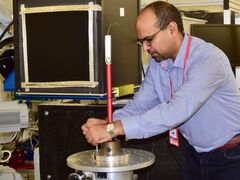 Manoj preparing samples prior to the imaging at Diamond Light Source. Image credit: Professor Ed Rhodes, University of Sheffield Manoj preparing samples prior to the imaging at Diamond Light Source. Image credit: Professor Ed Rhodes, University of Sheffield For millions of people across the globe, rice is the foundation of their diet. But this particular crop can contain unsafe levels of arsenic: a poisonous mineral that can cause death. One project funded by the STFC Food Network+ is seeking to understand how exactly arsenic accumulates in rice, which could ultimately inform safer production and cooking practices. Arsenic naturally occurs in underlying rock, particularly in the regions that border the Himalayan mountain range such as India and Bangladesh. This means that arsenic can easily contaminate groundwater in these regions. “Most people in these regions are aware that they shouldn’t drink water contaminated with arsenic” says Manoj Menon, a lecturer of environmental soil science at the University of Sheffield. “But there is a wider issue of arsenic accumulating in the food chain. Rice is especially problematic because it is a very thirsty plant that takes up a lot of water”. Indeed, for typical paddy-field style irrigation systems, it takes an estimated 2,500 litres of water to produce a single kilogram of unmilled rice. Furthermore, for many countries in south Asia, the average daily rice consumption can be as high as 500g-700g per day (pre-cooked weight), compared with just 15g for Europe. Clearly, this issue needs a holistic approach where crop breeding, irrigation schemes and cooking methods are all optimised to reduce arsenic contamination in rice. But before this can start, many fundamental gaps in our understanding need to be answered. Manoj began this task by asking how arsenic is distributed within the rice grains themselves – does it concentrate in particular regions or is it present throughout? To answer this, he turned to the UK’s national synchrotron Diamond Light Source, based at the Science and Technology Facilities Council’s Rutherford Appleton Laboratory. Diamond works like a giant microscope, but is 10,000 times more powerful than traditional models. It harnesses the power of electrons by accelerating them to near-light speeds, so that they give off light a billion times brighter than the sun. The light is directed into laboratories known as ‘beamlines’, where it is used to study anything from viruses and vaccines to ancient scrolls and jet engines. “Our samples were longitudinal sections of individual white rice grains, less than a millimetre thick” says Manoj. Using the X-ray beamline, Manoj produced a high-resolution map comparing the distribution of arsenic with other compounds. Crucially, arsenic was mostly concentrated around the outer layers of the grains. The essential nutrient zinc, on the other hand, was present around the embryonic part of the seed. “This fits previous works and also suggests that arsenic levels could be reduced without affecting the abundance of important micronutrients. This could be through refining the polishing process that removes the outer bran layer, or through alternative cooking methods”. Following this, Manoj investigated how arsenic levels varied across different rice cultivars and genotypes. His range of samples covered 55 different varieties, including both wild rice and supermarket brands. “We looked at brown rice, white rice, long grain, short grain, medium grain, organically produced and non-organically produced” says Manoj. Since it took between eight and nine hours to produce each high-resolution map using the Diamond Light Source, Manoj used classic analytical techniques to allow a faster comparison: Liquid Chromatography and Mass Spectrometry. Reassuringly, the results showed that for most of the samples, the levels of arsenic fell well below the European safety threshold for adults of less than 0.25 milligrams per kilogram. However, many of the samples exceeded the threshold for children, who have a much lower safety limit of 0.1 milligrams per kilogram. “In particular the highest arsenic levels were seen in organic rice samples” says Manoj. The results also confirmed previous studies which found that brown rice has higher arsenic levels than white. But Manoj cautions against avoiding brown rice on this principle: “Brown rice has health benefits not found in white rice, including higher levels of fibre, vitamins and minerals”. Since these initial results, the project has taken on a momentum of its own. “After this work with the STFC Food Network+, we have secured additional funding from the Global Challenges Research Fund, which allowed us to set up an Arsenic in Rice Research Network (ARRNet)” Manoj says. He is currently using this to investigate how different cooking methods may affect the distribution of arsenic, besides conducting surveys to understand how aware people in India and Bangladesh are of arsenic contamination in rice. A rice field experiment has been planned in India in 2020-21 to optimise irrigation practices. “Our long-term goal is to apply this knowledge in these regions to help people live with arsenic in the environment” Manoj says. “This initial small grant from the STFC Food Network+ acted as a spark that has really changed my life a lot” he adds. “It is a brilliant initiative to have small pots of money available that are easier for researchers to access than big grants with more competitive and lengthy application processes. This helps to get projects started”. Despite his work, he still enjoys a good plate of rice, and advises that Europeans shouldn’t be too worried about arsenic contamination. “Our message is that it is the total amount of rice you eat that is the main risk factor” he says. “For the average consumption rate of Europeans, arsenic contamination shouldn’t be a problem, although it is perhaps best to restrict how much rice children are given”. Manoj and his team have had two papers published on this project: Menon et al (2020) Do Arsenic levels in rice pose a health risk to the UK population? Ecotoxicology and Environmental Safety Menon et al (2020) Improved rice cooking approach to maximise arsenic removal while preserving nutrient elements
1 Comment
7/2/2023 06:10:36 pm
I appreciate the research and effort you put into this post. It shows."
Reply
Your comment will be posted after it is approved.
Leave a Reply. |
AuthorJune 2024 - Archives
June 2024
Categories |
- Home
- Webinars and Events
- About the SFN+
- News
- Blog
- Expert Working Groups
- Funding
-
Publications
- Bioeconomy positioning paper
- SFN+ 5th Annual Conference
- OMM Policy Report
- ‘Multi-Stakeholder International One Day Workshop on Organic Agri-Food Value Chains for Net Zero’ Report
- SFN 2050 UK Net Zero Food report
- Sustainable Cold Food Chain Booklet
- Food Sensing Technologies for Safe and Nutritious Food
- Sustainable urban and vertical farming
- Projects
- Join/Contact Us

 RSS Feed
RSS Feed


